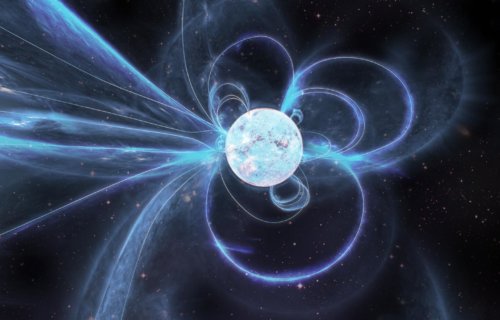GINGIN, Australia — If you’ve ever played with magnets, you’d know there is very little a person can do to change the forces that push and pull those magnets apart. In deep space, astronomers think of stars in that same way. Now, however, a team in Australia has discovered one of strongest magnetic forces in the universe is acting very strangely. Astronomers from the ARC Centre of Excellence for Gravitational Wave Discovery (OzGrav) and the Commonwealth Scientific and Industrial Research Organization (CISRO) say a rare type of neutron star is sending out bizarre radio pulses which have never been seen before from a magnetar like this.
Magnetars are a rare variety of rotating neutron star with some of the most powerful magnetic fields observed in space. To date, scientists have only detected 30 of these objects around our galaxy — the Milky Way. Most of these stars were discovered by X-ray telescopes after the magnetars gave off a high-energy burst.
Some of these stars produce radio pulses, just like their less-powerful cousins (pulsars) which give off radio waves from their magnetic poles.
The strange case of Swift J1818
In March 2020, scientists discovered a new magnetar, naming it Swift J1818.0-1607. Unlike other “radio-loud” magnetars however, J1818’s radio pulses were much different than what astronomers typically see.
Most radio pulses magnetars give off have a consistent brightness across a wide range of frequencies. J1818’s pulses on the other hand were much brighter at low frequencies than they were at high ones. This is similar to the behavior of a pulsar, which is also a radio-emitting neutron star.
To find out what was going on, the OzGrav team observed the new magnetar eight times from May to October 2020 using the CSIRO Parkes radio telescope. During the investigation, J1818 continued its odd behavior for several months. In May, it was still producing those same, unusual pulsar-like pulses. In June however, J1818 suddenly starting flickering between a bright and weak state.
This flickering reached a peak in July when the strange magnetar started going back and forth between giving off pulsar-like and magnetar-like radio pulses.
“This bizarre behavior has never been seen before in any other radio-loud magnetar,” says study lead author and Swinburne University/CSIRO PhD student Marcus Lower in a media release. “It appears to have only been a short-lived phenomenon as by our next observation it had settled permanently into this new magnetar-like state.”
What’s causing J1818’s identity crisis?
Researchers compared their observations to a 50-year-old theoretical model of how pulse shape and brightness changes according to radio frequency. The model helps scientists predict the general geometry of a pulsar, based on the twisting direction of the star’s light. In J1818’s case, it appears the magnetar is a uniquely misaligned stellar phenomena.
“From our observations, we found that the magnetic axis of J1818 isn’t aligned with its rotation axis,” Lower says. “Instead, the radio-emitting magnetic pole appears to be in its southern hemisphere, located just below the equator. Most other magnetars have magnetic fields that are aligned with their spin axes or are a little ambiguous. This is the first time we have definitively seen a magnetar with a misaligned magnetic pole.”
While J1818 might be out of its proper alignment, researchers say the star still appears stable. The teams believes any pulse changes which occur are due to variations in the height of the radio pulses coming from the star’s surface.
Of course, that doesn’t mean J1818 can’t keep surprising astronomers. In August, the team witnessed an even more bizarre event.
“Our best geometric model for this date suggests that the radio beam briefly flipped over to a completely different magnetic pole located in the northern hemisphere of the magnetar,” Lower explains.
Another magnetic mystery
Researchers say a lack of changes in the shape of the magnetar’s pulses lead them to believe that J1818’s magnetic field lines — which trigger “normal” radio waves — are also responsible for making the pulses at the other pole.
The study suggests that J1818’s radio pulses come from loops of magnetic fields which connect those two closely spaced poles. In other words, this magnetar acts like a horseshoe magnet here on Earth. This is completely different from typical neutron stars which have a north and south pole on the star’s opposite sides. For ordinary stars, this creates a more donut-shaped magnetic field.
The NICER telescope on board the International Space Station also confirmed these odd readings from J1818. Researchers say the discovery will help scientists learn more about how magnetars are born and evolve over time. J1818’s sudden flip in August may also allow astronomers to map out the magnetic fields of magnetars.
“The Parkes telescope will be watching the magnetar closely over the next year” adds scientist and study co-author Simon Johnston from the CSIRO Astronomy and Space Science.
The study appears in the Monthly Notices of the Royal Astronomical Society.
